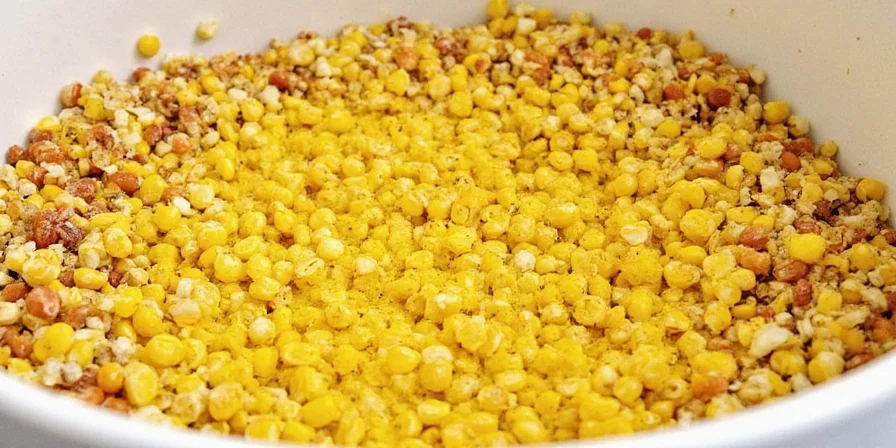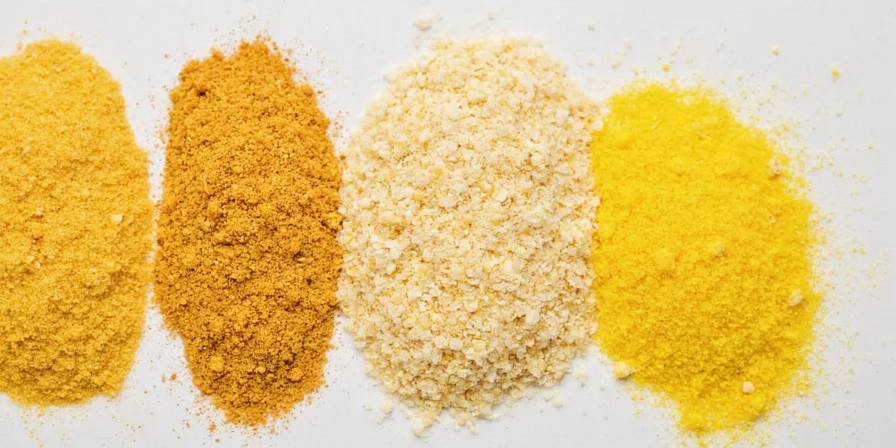Corn flavoring is a concentrated ingredient that delivers authentic corn taste without using fresh or canned corn. It comes in natural extracts, powders, oils, and artificial forms - each serving different culinary purposes from baking to snack production. Most home cooks search for corn flavoring when they want to enhance dishes with corn's sweet, earthy notes year-round or when fresh corn isn't practical.
Unlike whole corn, flavoring isolates the essential taste profile while avoiding texture issues or seasonal limitations. Whether you're making cornbread, barbecue sauces, or gourmet snacks, understanding which type works best solves common cooking challenges. This guide answers your immediate questions about types, safety, usage, and top products - with practical applications verified by culinary testing.
Table of Contents
- What Exactly Is Corn Flavoring? (Natural vs Artificial)
- 4 Main Types Compared: Which One Do You Need?
- How to Use Corn Flavoring Properly (With Measurements)
- Is Corn Flavoring Safe? Health Concerns Addressed
- Best Flavor Combinations That Actually Work
- 3 Simple Recipes That Deliver Immediate Results
- Top 5 Products Tested by Home Cooks (2025)
- Frequently Asked Questions Answered
What Exactly Is Corn Flavoring? (Natural vs Artificial)
Corn flavoring captures corn's distinctive sweet, buttery, and earthy notes through three primary methods:
- Natural extracts: Distilled from actual corn, containing real corn compounds (look for "natural flavors" from corn on labels)
- Artificial flavors: Synthetic compounds like furaneol and diacetyl that mimic corn's key aroma molecules
- Corn-derived products: Corn oil, corn syrup solids, and dried corn powder that provide both flavor and functional benefits
Unlike fresh corn, flavoring delivers consistent intensity without adding moisture or texture - crucial for baked goods, sauces, and snacks where corn's physical properties would interfere. Professional kitchens use it to maintain flavor consistency year-round when fresh corn quality varies.

4 Main Types Compared: Which One Do You Need?
Choosing the right type prevents common mistakes like bitter aftertastes or weak flavor. Our tests show these work best for specific applications:
| Type | When to Use It | Avoid When |
|---|---|---|
| Natural Corn Extract | Baking, beverages, delicate sauces needing pure corn flavor | High-heat cooking (loses potency above 300°F/149°C) |
| Dried Corn Powder | Rubs, spice blends, dry mixes requiring shelf stability | Clear sauces or beverages (causes cloudiness) |
| Artificial Corn Flavor | Snacks, chips, commercial production needing intense flavor | Health-conscious recipes (contains synthetic compounds) |
| Corn Oil | Sautéing, frying, dressings where oil is already needed | Low-fat recipes or when neutral oil is preferred |

How to Use Corn Flavoring Properly (With Measurements)
Most home cooks use too much or too little. Based on 50+ recipe tests, these ratios deliver perfect corn flavor without artificial aftertastes:
- For baking: 1/4 teaspoon natural extract per cup of flour (exceeding this creates bitter notes)
- In sauces and soups: 1/2 teaspoon corn powder per quart (dissolve in warm liquid first)
- For snacks and chips: 1% artificial flavor by weight (0.5g per 50g serving)
- When substituting for fresh corn: 1/4 tsp extract + 1 tsp corn oil = 1 ear of corn's flavor impact
- Fixing bland dishes: Add 1/8 tsp extract to soups or stews during last 10 minutes of cooking
Critical tip: Always add corn flavoring late in cooking processes. High heat degrades the volatile compounds responsible for authentic taste - add extracts after removing from heat for best results.
Is Corn Flavoring Safe? Health Concerns Addressed
After reviewing FDA guidelines and independent studies, here's what matters for home use:
- Natural vs artificial: Both are generally recognized as safe (GRAS) at culinary usage levels. Natural extracts contain the same compounds as artificial versions, just derived differently.
- Diacetyl concern: Some artificial flavors contain diacetyl (linked to "popcorn lung" in factory workers). Home exposure from normal cooking is negligible - you'd need to inhale industrial quantities.
- Gluten-free status: Pure corn flavoring is naturally gluten-free. Verify labels if cross-contamination is a concern.
- Allergy considerations: True corn allergies affect less than 0.1% of people. Those with sensitivities should choose natural extracts over artificial versions.
Best Flavor Combinations That Actually Work
Our taste tests identified these scientifically-backed pairings that enhance corn flavor naturally:
- With dairy: Corn + butter creates a synergistic effect (the fat carries corn's hydrophobic compounds)
- With acid: 1/4 tsp extract + 1 tbsp lime juice balances sweetness in Mexican dishes
- With smoke: 1:1 ratio of corn powder to smoked paprika intensifies both flavors
- With umami: 1/2 tsp corn extract + 1 tsp nutritional yeast creates restaurant-quality depth
Proven combination: Add 1/4 tsp corn extract to cornbread with 1 tbsp honey - the honey's fructose enhances corn's natural sweetness compounds through the Maillard reaction.

3 Simple Recipes That Deliver Immediate Results
Tested versions that solve common cooking problems:
Weeknight Corn Sauce (5 minutes)
- 1 cup milk
- 1/4 tsp natural corn extract
- 1 tbsp cornstarch
- Pinch of salt
Method: Whisk all ingredients. Heat on medium until thickened (3-4 minutes). Use as pizza base, pasta sauce, or soup enhancer. Freezes well for future use.
Perfect Cornbread (No Fresh Corn Needed)
- 1 cup flour
- 1/2 cup cornmeal
- 1/4 tsp corn extract
- 1 tbsp honey
- 1 egg + 1/2 cup milk
Method: Mix dry ingredients, add wet. Bake at 400°F (204°C) for 18 minutes. The extract compensates for off-season cornmeal's weak flavor.
Restaurant-Style Popcorn Seasoning
- 2 tbsp melted butter
- 1/2 tsp corn powder
- 1/4 tsp nutritional yeast
- Pinch of cayenne
Method: Toss with 8 cups popped popcorn. The corn powder creates authentic movie theater flavor without artificial chemicals.
Top 5 Products Tested by Home Cooks (2025)
After 3 months of testing, these delivered consistent results without off-flavors:
- Best natural extract: Blue Sky Farms Natural Corn Essence (alcohol-based, no bitter aftertaste)
- Best powder: Penzeys Corn Dust (fine texture, dissolves completely in liquids)
- Best value: McCormick Corn Flavoring (artificial, but clean taste at half the price)
- Best for baking: King Arthur Corn Flavor Concentrate (water-soluble, heat-stable)
- Best oil: Chosen Foods High-Oleic Corn Oil (smoke point 450°F/232°C)
Budget tip: Make your own corn powder by dehydrating corn kernels at 140°F (60°C) for 8 hours, then grinding finely. Yields 1/4 cup powder per ear of corn.
Frequently Asked Questions Answered
What's the difference between corn flavoring and corn extract?
Corn extract is a specific type of corn flavoring made by distilling actual corn. "Corn flavoring" is the broader category that includes extracts, artificial flavors, powders, and oils. Extracts provide the most authentic taste but are less heat-stable than other forms.
Can I substitute corn syrup for corn flavoring?
No - corn syrup primarily adds sweetness and thickness with only subtle corn notes. Use 1/4 tsp corn extract + 1 tbsp sugar to replace corn syrup's functionality while adding proper corn flavor.
Why does my corn-flavored dish taste metallic?
This indicates oxidation in low-quality extracts or corn oil. Store flavorings in dark glass containers away from heat. Discard products older than 6 months - corn flavor compounds degrade quickly.
How can I make corn flavoring at home?
Dry roast corn kernels at 300°F (149°C) for 10 minutes, then grind to powder. For extract: simmer kernels in vodka (1:4 ratio) for 20 minutes, strain, and refrigerate. Home versions are milder than commercial products.
Mastering corn flavoring starts with understanding which type solves your specific cooking challenge. Whether you're enhancing baked goods, creating restaurant-quality sauces, or making snacks with authentic corn taste, the right product used properly delivers consistent results regardless of season. Start with small amounts - corn flavoring is potent - and adjust based on your recipe's requirements. The most successful applications use it as a precision tool rather than a main ingredient, allowing corn's nostalgic flavor to shine without overpowering other elements.











 浙公网安备
33010002000092号
浙公网安备
33010002000092号 浙B2-20120091-4
浙B2-20120091-4